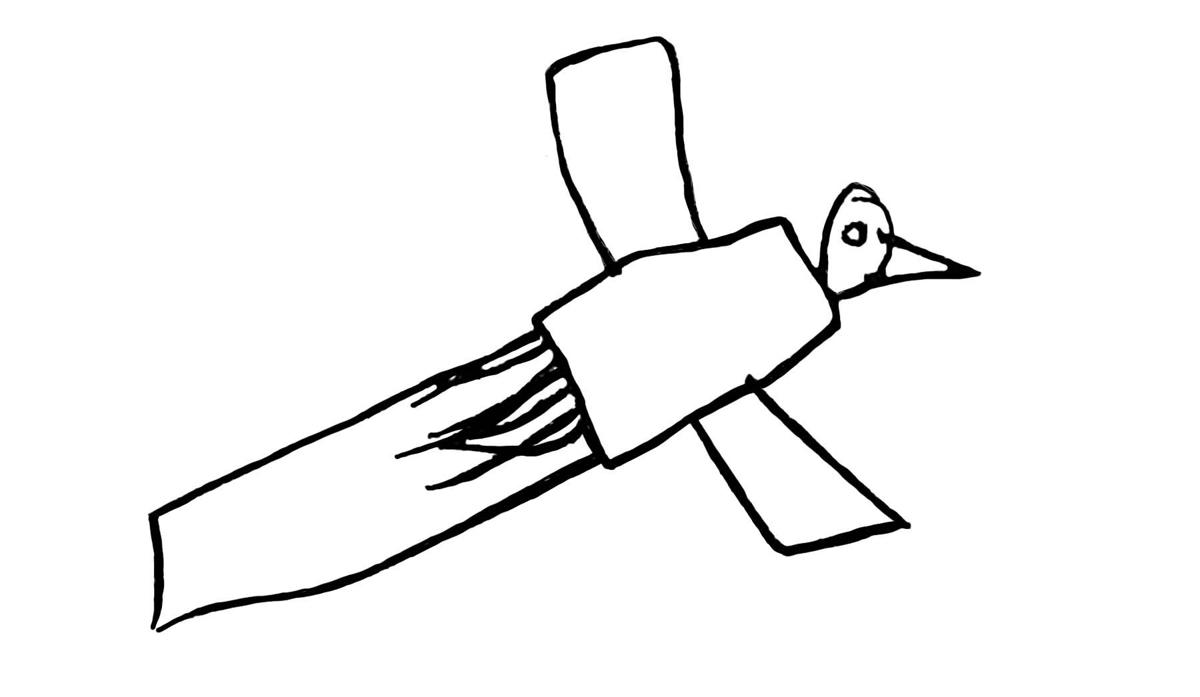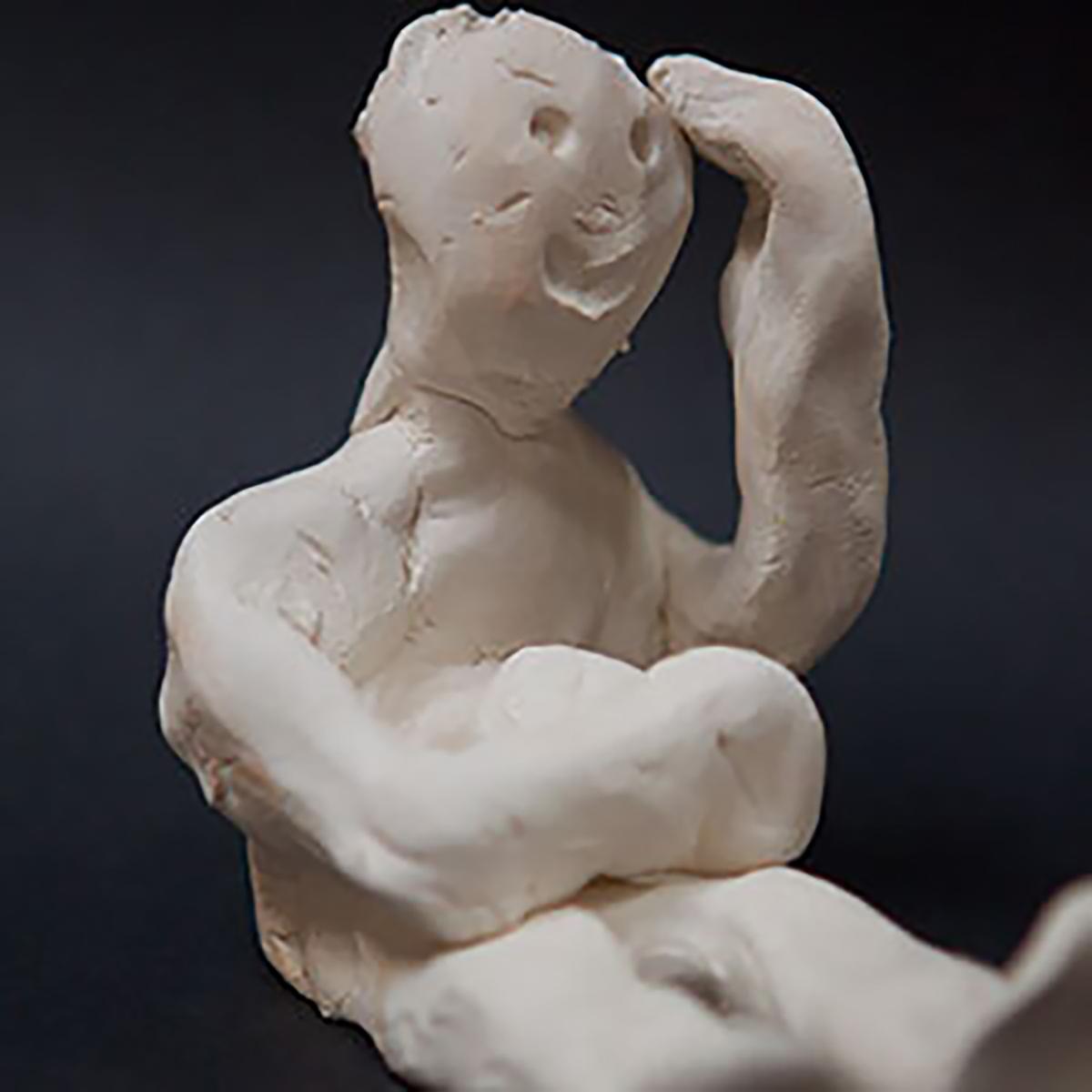March 26: Biological and Spiritual Natures
♫ Music:
Tuesday, March 26
Biological and Spiritual Natures
Scripture: 1 Corinthians 15:45
“The first man Adam became a living being”; the last Adam became a life-giving spirit.
Poetry:
You Are Not Christ
by RIckey Laurentiis
New Orleans, Louisiana
For the drowning, yes, there is always panic.
Or peace. Your body behaving finally by instinct
alone. Crossing out wonder. Crossing out
a need to know. You only feel you need to live.
That you deserve it. Even here. Even as your chest
fills with a strange new air, you will not ask
what this means. Like prey caught in the wolf’s teeth,
but you are not the lamb. You are what’s in the lamb
that keeps it kicking. Let it.
SPIRIT & FLESH: FRIENDS OR FOES?
The poem, art, and music for this day emphasize the radical difference between spirit and flesh. The child’s weighty clay figure of an embodied human contrasts with the light line-drawing on paper that seems to fly off the page. The poem too begins by telling you what you are not: you are not Christ, the death-defier. Instead of lightly walking on water, you drown. And yet the poem points to the strange reality that we are spiritual beings: “you are not the lamb – you are what’s in the lamb.” We are our bodies – and yet that is not all to be told about us. Playfully, the Woodie Guthrie song underscores the mystery of it all: the child’s questioning of reality “why oh why oh why” followed by the adult’s exasperated “because because because / goodbye goodbye goodbye.”
But this is no child’s question to be pushed to the side. As Ecclesiastes 3:11 says, “He has set eternity in the human heart.” If we are human, are we more than our bodies? Are we also spirit? How can these two exist together? And as we face death, do we surrender to “instinct alone,” “cross out wonder,” and simply “let it”? Or is there more?
In many ways, Jesus is both the question and the answer to this question. He has been given to us as the one “Archimedean point” beyond our humanity (says Barth) to allow us to see ourselves truly, for who we really are. More often than not, we look to Jesus to show us what God is like. But Jesus is also God’s revelation of ourselves to us. We need Jesus’ revelation to help us think about ourselves, else we resort to “because because because.”
Jesus’ resurrected body is the key. Jesus’ resurrected body unites our solid physicality and the Spirit forever. Paul highlights the fact that we all, following in Adam’s footsteps, will die. The breath that Adam was given in Genesis 2 came to an end. And yet Jesus’ body has become an eternal spring. As the second Adam, he is now the location of the Spirit, being poured out upon us from the right hand of the Father. This contrast is critical to Paul’s anthropology: we are now in Christ. Because of Jesus’ body, our bodies participate in his body, which is now the location of the new creation. Rather than become more “spiritual,” life in the Spirit is now more concrete, more embodied, more “solid,” if you will, because Christ’s ascended body has forever bound the flesh and the Spirit together.
We are tempted to contrast the child’s clay figure and bird drawing as irreconcilable. But Christ’s body forever has joined the spiritual and the physical worlds in a union that we cannot sunder. We do not have to choose between our bodies and our spirits! Christ has brought our humanity permanently into the presence of the Father, as a permanent benediction upon what it is to be human. “Let it.” Hallelujah.
Prayer:
God be in my head,
and in my understanding;
God be in mine eyes,
and in my looking;
God be in my mouth,
and in my speaking;
God be in my heart,
and in my thinking;
God be at mine end,
and at my departing.
From the Book of Hours, 1514
Dr. Julie Canlis
Professor of Theology,
Whitworth University
Spokane, Washington
For more information about the artwork, music, and poetry selected for this day, we have provided resources under the “About” tab located next to the “Devotional” tab.
About the Artwork:
Clay Figure and Bird Drawing
Unidentified Children Artists
Seeing the simplicity of a child’s creativity can help bring us to the one of the essential creative acts of God; the making of flesh and spirit. The clay figure was an exercise given to some 4th grade children in an art class. They were shown works by sculptor Auguste Rodin and then given 90 minutes to make a clay figure. The child's bird drawing was done from experience and memory before the children were taught how to draw a typical bird.
About the Artists:
Unidentified Children Artists
About the Music:
“Why Oh Why” from the album Tumblebee
Lyrics:
Why, oh why, oh why oh, why
Why, oh why, oh why
Because because because because
Goodbye goodbye goodbye
Why can't a bird eat an elephant
Why, oh why, oh why
'Cause an elephant's got a pretty hard skin
Goodby goodbye goodbye
Why can't a mouse eat a streetcar
Why, oh why, oh why
'Cause a mouse's stomach could never hold a streetcar
Goodbye goodbye goodbye
Why does a horn make music
Why, oh why, oh why
'Cause the horn-blower blows it
Goodbye goodbye goodbye
Why does a cow drink water
Tell me why and why
Because the cow gets thirsty just like you or me
Goodbye goodbye goodbye
Why, oh why, oh why oh, why
Why, oh why, oh why
Because because because because
Goodbye goodbye goodbye
Why won't you answer my questions
Why, oh why, oh why
'Cause I don't know the answers
Goodbye goodbye goodbye
Why's there no pennies for ice cream
Why, oh why, oh why
You put all the pennies in the telephone, dear
Goodbye goodbye goodbye
Why can't a rabbit chase an eagle
Tell me why, oh why
Because because
Rob from always on the run is so bad and copy paste is a sin
Why ain't my grandpa my grandma
Why, oh why, oh why
Same reason your dad's not your mommy
Goodbye goodbye goodbye
Why couldn't the wind blow backwards
Why, oh why, oh why
'Cause it might backfire and hurt somebody
Goodbye goodbye goodbye
Why, oh why, oh why oh, why
Why, oh why, oh why, oh why
Because because because because
Goodbye goodbye goodbye
About the Composer and Lyricist:
Woodrow “Woody” Wilson Guthrie (1912–1967) was an American singer-songwriter and one of the most significant figures in American folk music. Over his lifetime he wrote over 300 songs, including such staples in the canon of American music including: This Land Is Your Land, This Train Is Bound For Glory, Do Re Mi, Vigilante Man, and Dust Bowl Refugee. Songwriters such as Bob Dylan, Johnny Cash, Bruce Springsteen, Bono, Pete Seeger, and Jerry Garcia have been inspired by his music. Woody’s music and politics were solidly intertwined and he felt his music could be an agent to affect social change. His songs supported the rights of workers and those on the margins of society; they attacked unfairness in the American economic system and injustice to immigrants. His legacy continues with his son singer-songwriter Arlo Guthrie and other Guthrie family members who have become entertainer/musicians.
About the Performer:
Laura Pauline Veirs (b. 1973) is an American singer-songwriter. She is known for her folk/alternative country records and live performances. Her family-geared album Tumblebee includes rollicking and soulful folk songs with captivating vocals and a delightful mix of harmonies, guitars, banjo, piano, percussion, accordion, brass, strings and whistles. It is a winner of a Parents Choice Award Gold Medal. The track “Why Oh Why” ironically captures the insatiable curiosity of childhood and the limits of a grown-up’s patience. This song is a humorous reminder that we are designed ask questions no matter what our age, and that, thankfully, our Father has inexhaustible patience.
About the Poet:
Rickey Laurentiis (b. 1989) is an American writer and the author of Boy with Thorn, selected by Terrance Hayes for the 2014 Cave Canem Poetry Prize (University of Pittsburgh Press). He is recipient of a 2014 fellowship from the Civitella Ranieri Foundation in Italy, a 2013 Creative Writing Fellowship from the National Endowment for the Arts, and a 2012 Ruth Lilly Poetry Fellowship. Laurentiis was raised in New Orleans, Louisiana, and his poems “trace the complex relationships among power, freedom, and violence with both sinuous lyricism and urgent declamation.” His work has appeared in The New Republic, the New York Times, Poetry, and many other places. He has taught at a selection of institutions, including Columbia University and Sarah Lawrence College.
About the Devotional Writer:
Dr. Julie Canlis
Professor of Theology
Whitworth University
Dr. Julie Canlis currently teaches at Whitworth University in their theology MA program. She received a Ph.D. in Theology from the University of St Andrews, a Masters of Christian Studies from Regent College, and has a B.A. in Comparative History of Ideas from the University of Washington. She is the author of Calvin’s Ladder (2010, Templeton Prize) and A Theology of the Ordinary (2017). She and her husband, Matt, ministered in the Church of Scotland for thirteen years and co-founded The Abbey Summer School – a “pop up” seminary that has been running since 2013 in Edinburgh, Scotland. She also runs the non-profit Godspeed. She stays at home with their four children, and teaches Sunday School for 6-8 year olds. She is committed to slow food and slow church.

